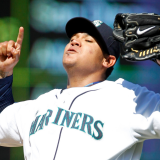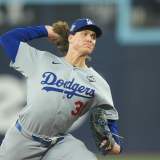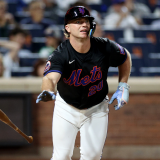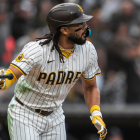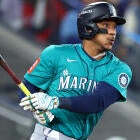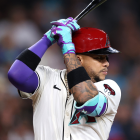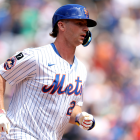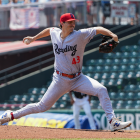
How Mets turned their season around: Francisco Lindor's resurgence among four reasons why New York is in NLCS
An incredible second-half run has carried the Mets all the way to the NLCS
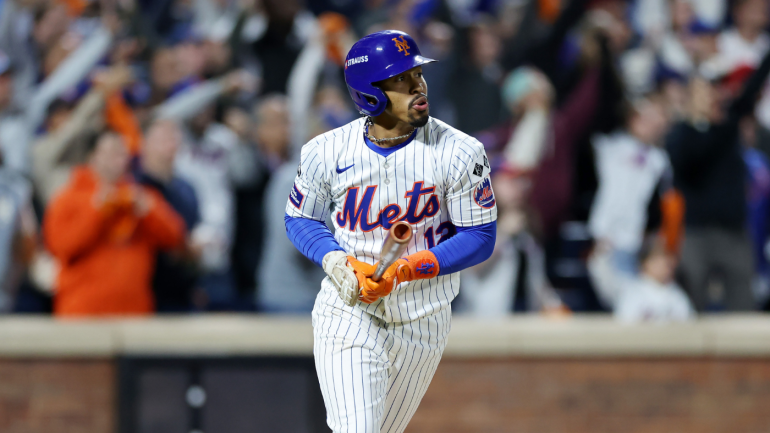
One of the most threadbare and true descriptions of baseball is that it's a game of adjustments. The difference between average and good players, it's often been theorized, is not necessarily physical ability, but the capacity for changing what needs to be altered in order to either keep up or get ahead of the competition. That can mean a host of things: fashioning a new pitch, steadying mechanics, out-scheming the opposition, solving for what the opponent is trying to do before they do it, and so on.
It ought to go without writing that every player and every team has to make some kind of adjustments throughout the season. That's simply the warp and woof of the game. Some players' and some teams' changes are more noticeable from the outside, however. We find that to be especially true of this edition of the New York Mets, who will resume their quest for the National League pennant on Sunday night as they face the top-seeded Dodgers in Game 1 of the NLCS.
The coming days will determine how history remembers these Mets. From our perspective, they've already solidified themselves as a squad that dug a hole and then invented a way out of it. They overcame a brutal start (they were 11 games under .500 and possessed the third-worst record in the NL in early June) and made the playoffs against all odds. The Mets' course correction wasn't just the product of luck, though that plays a role in all successes and failures; it was, too, the product of players and team figuring out what worked and what didn't and willing their games into alignment.
As such, we wanted to highlight four particular changes the Mets and their players made throughout the year that helped them save their season and earn a spot in the NLCS. (Do note that these are presented in no particular order, and that we're aware we could've ran this piece much deeper were it not for length concerns.)
Let's get to it.
1. Manaea drops his arm angle
You may have heard about this already. If not, Sean Manaea was inspired to tweak his mechanics more than halfway through the season after watching Chris Sale. Not only did Manaea drop his arm angle (his vertical release height on his sinker in July was 5.46 feet versus the 5.08 feet he averaged in September), but he added a crossfire element that sees him warm up by throwing to a catcher located behind the other bullpen plate.
Sean Manaea vs. Chris Sale, Mechanics pic.twitter.com/lKDcUJP1Na
— Rob Friedman (@PitchingNinja) October 8, 2024
While it's always risky to tinker with one's delivery and arm slot, particularly in-season, the gamble to be more like Sale paid off for Manaea. Take a look at his numbers up to and after July 30, when he first started to lower his release point:
- Pre-July 30: 20 GS, 3.74 ERA, 2.24 SO/BB
- July 30-onward: 12 GS, 3.09 ERA, 4.61 SO/BB
Clearly the deception Manaea added to his game -- both with the flatter release point and the crossbody effect -- helped him finish strong. The Mets needed every bit of that boost to make the playoffs, too, as they didn't clinch a spot until game No. 161.
2. Vientos takes over
Mark Vientos has developed into such a pivotal member of the Mets lineup that it's easy to forget he wasn't their Plan A at the hot corner.
Rather, the Mets entered the season with designs on Bretty Baty, a more decorated youngster, as the answer at third base. Vientos didn't make consecutive starts there until mid-May. Two weeks later, he was installed as the everyday starter. Vientos never looked back from there, hitting .266/.322/.516 (135 OPS+) with 27 home runs and 91 runs batted in overall in 111 regular season contests. (Baty, for his part, went on to hit .252/.349/.504 in Triple-A, but did not appear in an MLB game after June 9.)
MARK VIENTOS!
— MLB (@MLB) October 5, 2024
TIE GAME! #NLDS pic.twitter.com/1IaCtD7Mot
Vientos still leaves something to be desired defensively -- he's made a few gaffes during the playoffs -- and it'll be interesting to see if the Mets move him to a different position heading into next season (especially with first baseman Pete Alonso and designated hitter J.D. Martinez slated for free agency). There's no denying his offensive prowess, however, and that's what's going to keep him employed for years to come.
3. Lindor finds his groove
Speaking of early season predicaments that fell by the wayside. Do you recall how Francisco Lindor began the year? It sure wasn't in a way that left Citi Field chanting MVP. No, Lindor hit just .197/.280/.359 with five home runs and four stolen bases in April.
Whereas Lindor reliably hit the ball between 10 and 30 degrees 27% of the time or better in his first three seasons with the Mets, he's hit it in that window just 14.6% of the time so far. In layman's terms, that means Lindor isn't lining the ball as often; he's instead hitting the ball too steeply, either up into the air or down into the dirt.
Lindor very much recovered after April. He posted a .940 OPS or better in each of the last three months of the year, giving him a career-high 138 OPS+ overall and fueling that unlikely MVP talk.
FRANCISCO LINDOR. GRAND SLAM. #NLDS pic.twitter.com/CdKuEVOfT3
— MLB (@MLB) October 9, 2024
As for Lindor's batted-ball spray, let's put it this way: he finished with a 35.4% mark on the year, validating our assessment that he would be fine once he got his swing back on the correct plane.
4. Peterson re-joins the rotation
The Mets allotted 20 or more starts to four pitchers in 2024: Sean Manaea, Luis Severino, Jose Quintana, and David Peterson. Both Manaea and Severino had resurgent years, but it was Peterson who far and away led the quartet in ERA+ (136).
Peterson didn't open the season in the rotation. In fact, he didn't make his season debut until May 29, when the Mets were nearing their nadir, on account of the hip surgery he underwent last fall. Nevertheless, Peterson made up for missed time in a hurry, holding opponents to three runs or fewer in 17 of his 21 outings. Not bad for someone who, to be frank, appeared to be in a make-or-break season. (Remember, he had an 86 ERA+ over his previous 70 appearances, including 15 out of the bullpen.)
David Peterson's 6th & 7th Ks thru 3. pic.twitter.com/v4Qf26ExYp
— Rob Friedman (@PitchingNinja) September 3, 2024
Peterson has publicly credited his success this year to his corrected hip. Given the theme of this piece, we'd be remiss if we didn't note a few tweaks to his arsenal. This is the first time in his career he's used his sinker as his primary pitch; he also clearly altered his changeup, adding about three inches of drop to the pitch year-to-year.
Although Peterson has thus far worked out of the bullpen during the playoffs, we think it's fair to pencil him into the Mets' 2025 starting five. For now, though, the Mets can't afford to look too far ahead -- not when they have a chance to win the pennant.



